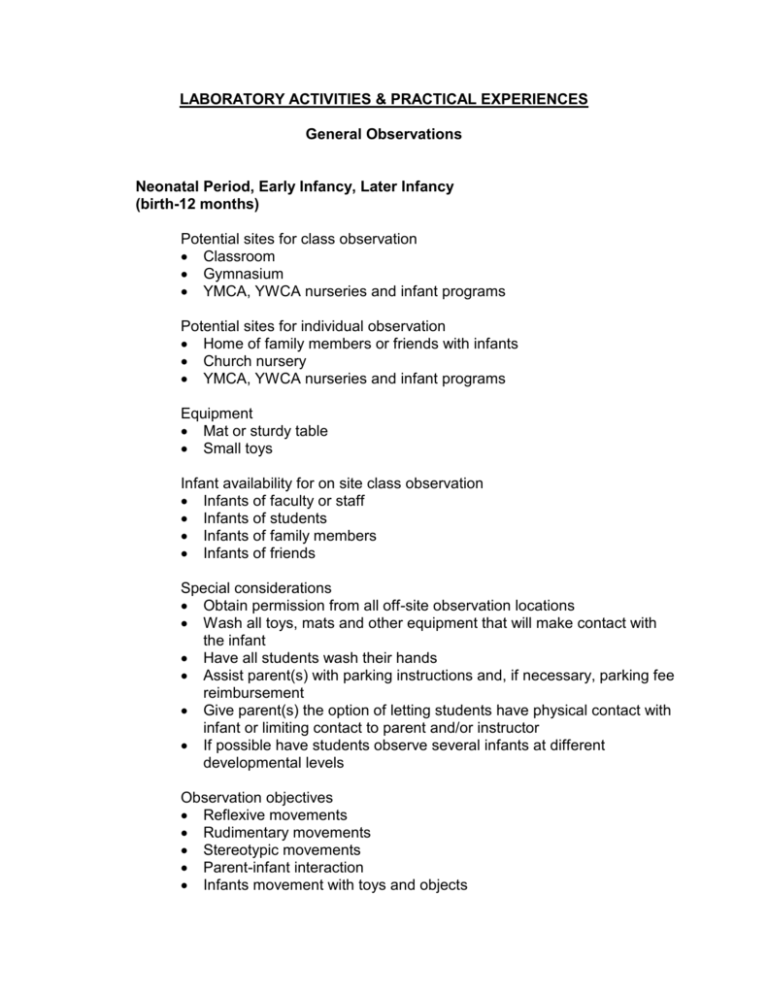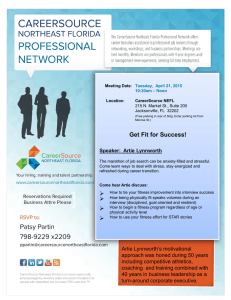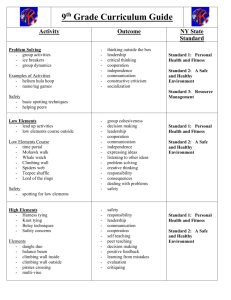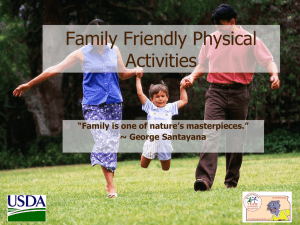General Observations
advertisement

LABORATORY ACTIVITIES & PRACTICAL EXPERIENCES General Observations Neonatal Period, Early Infancy, Later Infancy (birth-12 months) Potential sites for class observation Classroom Gymnasium YMCA, YWCA nurseries and infant programs Potential sites for individual observation Home of family members or friends with infants Church nursery YMCA, YWCA nurseries and infant programs Equipment Mat or sturdy table Small toys Infant availability for on site class observation Infants of faculty or staff Infants of students Infants of family members Infants of friends Special considerations Obtain permission from all off-site observation locations Wash all toys, mats and other equipment that will make contact with the infant Have all students wash their hands Assist parent(s) with parking instructions and, if necessary, parking fee reimbursement Give parent(s) the option of letting students have physical contact with infant or limiting contact to parent and/or instructor If possible have students observe several infants at different developmental levels Observation objectives Reflexive movements Rudimentary movements Stereotypic movements Parent-infant interaction Infants movement with toys and objects Toddler Period and Early Childhood (2-5 years) Potential sites for class observation Gymnasium Preschools and daycares YMCA, YWCA preschool programs Community schools (kindergarten and 1st grade) Potential sites for individual observation Preschools and daycares Home of family members or friends with young children YMCA, YWCA preschool programs Church programs Community schools (kindergarten and 1st grade) Equipment Mats, balls, beanbags, balloons, etc. Young child availability for on site class observation Young children of faculty or staff Young children of students Young children of friends Special considerations Obtain permission from all off-site observation locations Wash all toys, mats and other equipment that will make contact with the young child Have all students wash their hands Assist parent(s) with parking instructions and, if necessary, parking fee reimbursement If possible have students observe several young children at different developmental levels Observation objectives Fundamental movement skills Health-related fitness characteristics Performance-related fitness characteristics Parent-child interaction Child-other adult interaction Physical growth and maturation characteristics Cognitive development Affective development Middle and Later Childhood (6-10 years) Potential sites for class observation Gymnasium Community schools (kindergarten - 5th or 6th grade) Youth sport programs (school and community) Potential sites for individual observation Community schools (kindergarten - 5th or 6th grade) Youth sport programs (school and community) Home of family members or friends with older children Church programs Equipment Mats, balls, bats and rackets, beanbags, etc. Older child availability for on site class observation Older children of faculty or staff Older children of students Older children of friends Special considerations Obtain permission from all off-site observation locations Assist parent(s) with parking instructions and, if necessary, parking fee reimbursement If possible have students observe several older children at different developmental levels Observation objectives Fundamental movement skills Specialized movement skills Health-related fitness characteristics Performance-related fitness characteristics Parent-child interaction Child-other adult interaction Physical growth and maturation characteristics Cognitive development Affective development Adolescence (approximately 10-20 years) Potential sites for class observation Gymnasium Community schools (middle, junior high, high schools) Youth sport programs (school and community) Potential sites for individual observation Community schools (middle, junior high, high schools) Youth sport programs (school and community) Home of family members or friends with adolescents Home of younger friends of students Equipment Mats, balls, bats and rackets, etc. Adolescent availability for on site class observation Adolescent children of faculty or staff Adolescent children of students Adolescent children of friends Adolescent friends of students Special considerations Obtain permission from all off-site observation locations Assist parent(s) and/or adolescents with parking instructions and, if necessary, parking fee reimbursement If possible have students observe several adolescents at different developmental levels Observation objectives Fundamental movement skills Specialized movement skills Health-related fitness characteristics Performance-related fitness characteristics Parent-adolescent interaction Adolescent-other adult interaction Physical growth and maturation characteristics Cognitive development Affective development Young Adulthood (approximately 20-40 years) Potential sites for class observation Gymnasium College/university movement programs (scheduled physical education classes, intramural programs, etc.) Community sport programs Fitness centers, YMCA, YWCA Potential sites for individual observation College/university movement programs (scheduled physical education classes, intramural programs, etc.) Community sport programs Fitness centers, YMCA, YWCA Family members or friends Equipment Mats, balls, bats and rackets, etc. Young adult availability for on site class observation Faculty or staff Students Friends of instructor Friends of students Special considerations Obtain permission from all off-site observation locations Assist adults with parking instructions and, if necessary, parking fee reimbursement If possible have students observe several young adults at different developmental levels Observation objectives Fundamental movement skills Specialized movement skills Health-related fitness characteristics Performance-related fitness characteristics Physical growth and maturation characteristics Affective domain characteristics Middle Adulthood (approximately 40-65 years) Potential sites for class observation Gymnasium Community sport programs Fitness centers, YMCA, YWCA Potential sites for individual observation Community sport programs Fitness centers, YMCA, YWCA Family members or friends Equipment Mats, balls, bats and rackets, etc. Middle-aged adult availability for on site class observation Faculty or staff Students Friends of instructor Friends of students Special considerations Obtain permission from all off-site observation locations Assist adults with parking instructions and, if necessary, parking fee reimbursement If possible have students observe several middle-aged adults at different developmental levels Observation objectives Fundamental movement skills Specialized movement skills Health-related fitness characteristics Performance-related fitness characteristics Physical characteristics Affective domain characteristics Older Adulthood (approximately 65+ years) Potential sites for class observation Gymnasium Senior citizen centers Nursing care facilities Fitness centers, YMCA, YWCA Mall walking programs Potential sites for individual observation Senior citizen centers Nursing care facilities Fitness centers, YMCA, YWCA Family members or friends Mall walking programs Equipment Mats, balls, bats and rackets, etc. Older adult availability for on site class observation Faculty or staff Emeriti faculty Friends of instructor Friends of students Special considerations Obtain permission from all off-site observation locations Assist adults with parking instructions and, if necessary, parking fee reimbursement If possible have students observe several older adults at different developmental levels Observation objectives Fundamental movement skills Specialized movement skills Health-related fitness characteristics Performance-related fitness characteristics Functional daily living skills Physical characteristics Affective domain characteristics Projects associated with observations: Project 1. Have students select 1-3 movement tasks. These tasks should be easy to administer and require a minimal amount of equipment. Examples include a standing long jump, throw for distance, 20 meter run, etc. Ask a male and female from each developmental age period observed to complete the selected task or tasks (infancy would generally be excluded from comparison). Students can graph the data with "performance scores" on the y-axis and "age in years" on the x-axis. Students can include a written description of the plotted curve and discuss why the curve follows the path that it does. As this discussion is product-oriented in nature, a second discussion can focus on the process the participants demonstrated when completing their movement tasks. If whole class can not observe the performance of all developmental age groups, assign a specific developmental age group to groups of students. Each group would provide their data for the rest of the class. Project 2. When observing adolescents, have the students describe the variations in height, body types, and secondary sex characteristics. Have the students compare the degree of variations in the adolescent population with the degree of variations in childhood and young adult populations. Project 3. Prior to an infant observation, have the students develop an infant observation assessment instrument. Instrument items may include reflexes exhibited, rudimentary movements exhibited, birth weight and length, and Apgar score. Have the students use their instrument during the infant observation. Project 4. Have students observe a young infant at the beginning of the semester providing them with key variables to observe. Have students observe the same infant toward the end of the semester with the same key variables. Have them discuss the changes observed over a given period of time. Additional Projects: Project 1. Have students interview an older adult regarding his or her past and present health status and involvement in physical activity. Have students ask questions that attempt to address the underlying causes of the older adult's current health and physical activity status, namely life span lifestyle, opportunities or lack thereof, disease, and ageing factors. Project 2. Have students visit a drugstore and identify over-the-counter drugs that can impair the motor performance of older adults. Project 3. Have student visit a drugstore and identify over-the-counter drugs that may have a detrimental effect on the developing fetus and should be avoided during pregnancy. Project 4. In the gymnasium, group students in pairs. Have one of the partners demonstrate a particular fundamental locomotor, manipulative, or stability skill at either the initial, elementary, or mature level. Have the second partner identify the level at which the skill is performed and which characteristics demonstrated that define that skill level. Project 5. Have students select a fundamental locomotor, manipulative, or stability skill. Have the students develop a list of environmental and task factors that could influence how that skill would be performed. Project 6. Have students attempt to identify potential underlying causes of secular trends or possible secular trends through the last few centuries. Have students speculate as to what current events may have the potential to establish a secular trend.






